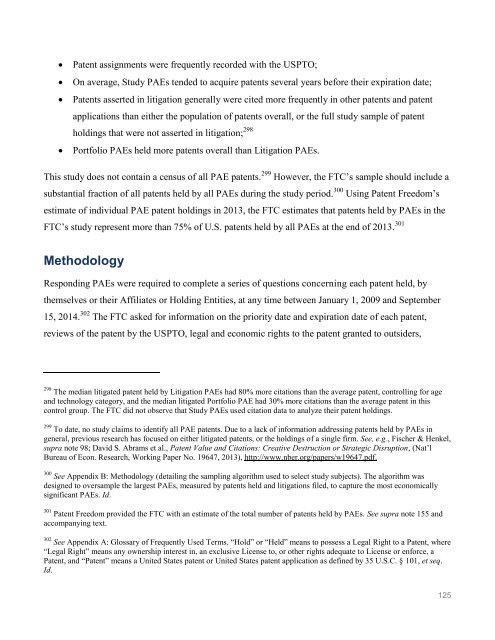Create successful ePaper yourself
Turn your PDF publications into a flip-book with our unique Google optimized e-Paper software.
<strong>Patent</strong> assignments were frequently recorded with the USPTO;<br />
On average, Study PAEs tended to acquire patents several years before their expiration date;<br />
<strong>Patent</strong>s asserted in litigation generally were cited more frequently in other patents and patent<br />
applications than either the population of patents overall, or the full study sample of patent<br />
holdings that were not asserted in litigation; 298<br />
Portfolio PAEs held more patents overall than Litigation PAEs.<br />
This study does not contain a census of all PAE patents. 299 However, the FTC’s sample should include a<br />
substantial fraction of all patents held by all PAEs during the study period. 300 Using <strong>Patent</strong> Freedom’s<br />
estimate of individual PAE patent holdings in 2013, the FTC estimates that patents held by PAEs in the<br />
FTC’s study represent more than 75% of U.S. patents held by all PAEs at the end of 2013. 301<br />
Methodology<br />
Responding PAEs were required to complete a series of questions concerning each patent held, by<br />
themselves or their Affiliates or Holding Entities, at any time between January 1, 2009 and September<br />
15, 2014. 302 The FTC asked for information on the priority date and expiration date of each patent,<br />
reviews of the patent by the USPTO, legal and economic rights to the patent granted to outsiders,<br />
298<br />
The median litigated patent held by Litigation PAEs had 80% more citations than the average patent, controlling for age<br />
and technology category, and the median litigated Portfolio PAE had 30% more citations than the average patent in this<br />
control group. The FTC did not observe that Study PAEs used citation data to analyze their patent holdings.<br />
299<br />
To date, no study claims to identify all PAE patents. Due to a lack of information addressing patents held by PAEs in<br />
general, previous research has focused on either litigated patents, or the holdings of a single firm. See, e.g., Fischer & Henkel,<br />
supra note 98; David S. Abrams et al., <strong>Patent</strong> Value and Citations: Creative Destruction or Strategic Disruption, (Nat’l<br />
Bureau of Econ. Research, Working Paper No. 19647, 2013), http://www.nber.org/papers/w19647.pdf.<br />
300<br />
See Appendix B: Methodology (detailing the sampling algorithm used to select study subjects). The algorithm was<br />
designed to oversample the largest PAEs, measured by patents held and litigations filed, to capture the most economically<br />
significant PAEs. Id.<br />
301<br />
<strong>Patent</strong> Freedom provided the FTC with an estimate of the total number of patents held by PAEs. See supra note 155 and<br />
accompanying text.<br />
302<br />
See Appendix A: Glossary of Frequently Used Terms. “Hold” or “Held” means to possess a Legal Right to a <strong>Patent</strong>, where<br />
“Legal Right” means any ownership interest in, an exclusive License to, or other rights adequate to License or enforce, a<br />
<strong>Patent</strong>, and “<strong>Patent</strong>” means a United States patent or United States patent application as defined by 35 U.S.C. § 101, et seq.<br />
Id.<br />
125


